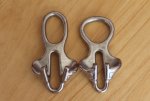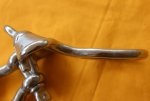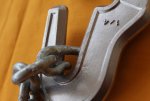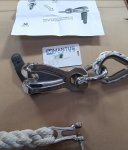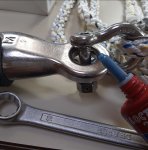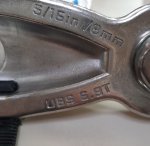sailaboutvic
Well-known member
Snubber ,
I just want to tell you of our experience 10 days ago , many here will know we are experience cruising and we live on our hook for 8 to 9 months every year and have been doing so for a very long time .
We been using a 14mm snubber in a V formation ( bridle ) on our 13.5 ton yacht,
Early hours on the 4th sept we was hit with a thunderstorm that's wasn't forecaster .
when we went to bed at 11.45 at which point other then thunderstorm some 300 miles away on the south of France there was no sign to concern us .
We would normally lay 7 meters of snubber in these light conditions, if there was any blow forecaster we lay 10 mts and plenty of chain.
This has seen us well in many storm conditions and never did I think we needed any thing longer because of the experience we had with this size snubber.
04.00 we had winds excess of 54 kts which when on for over hour and a half ,
I'm not making this up but part of the time the toe rail where in the water with the force of the wind and the boat pitching wildly .
Half way through this happening , we could hear the chain rattling every so offend ,
we knew we wasn't dragging so it took a few mins before I realise the chain was running out,
What was going through my head was if we get to the end of the chain the rope that connect in the locker was no way going to hold .
So it was a rush to sort the problem out ,
Going forward with a spare snubber In hailing rain in the dark and hanging on for dear life or so it felt like it ,
I connected the spare snubber between the windlass and the bow roller to stop any more chain running and as I was tighten it the boat dipped its bow the snubber hook came away and at force hit me just by my eye , another few mm and it would had taken my eye out .
Which left me with a very black eye .
Once thing settled down and at day light it turned out both snubber had snapped.
Being Bit taken back and shocked how two 14 mm both these rope broke I contact Jonathan Neeves to talk the problem over and get his option as I know he as done some test on snubber .
And he been very helpful , he confirmed that he would use Polyester Rope which is what we been using , and to use a bridle again which is what are set up is ,
Where we differ is he suggest taken it back to the winches , where our where always kept on the bow ,
So we will be taken his advice and extending the snubber to 20 mts each but because of the way the boat is we are unable to bring them to the winches without major conversion plus having to carry 40 mts of rope every time we anchor when most of the time there no need for it ,
I plain to split the number in four , leaving the snubber to 10 mts bridle but having an eye on the end of each rope , then having two more 10mts length with eye in so-when the time comes we can shackled them together, given us 20 mts bridle which we can then taken much further astern.
So what happen ?
I'm convince the snubber broke because
A of some wear inside the rope which couldn't be seen .
B we kept them in use for much too long so they where probity weaken ,
we be looking at replacing then every three years for now on .
Many here probably wouldn't be out anchoring in tho conditions but one has to remember thunderstorm can come from no where and even on the calmest of night and when not forecaster .
If we learned any thing it is replace snubber even if they look ok .
Connect the spare snubber what ever the conditions are to stop the chain being able to run if ever another snubber should break or the snubber hook some how falls off .
As for my eye , we consulted and eye specialist which to my relief he said there no long term damage and the lines I seeing will in time go ,
I consider myself very luck .
Jonathan thanks for your advise and the files you send me ,
You been very helpful and give lots of your time .
At less I know we was on the right road even tho the snubbers wasn't as long as they could had been .
Here a couple of facts .
We have many cruisers friends from around the world who we in touch with and many been in touch to see how I was
Ask about their snubber , many only have snubber no more then 7 or 10 mts
And no one have said they replace very often and only replace then if they start to wear .
Nearly everyone said they going to replace old snubber more then four years old this winter and many are now looking at they arrangement .
Maybe it's time you look at your ,
I got away lightly with a black eye .
It could have been much worst .
I just want to tell you of our experience 10 days ago , many here will know we are experience cruising and we live on our hook for 8 to 9 months every year and have been doing so for a very long time .
We been using a 14mm snubber in a V formation ( bridle ) on our 13.5 ton yacht,
Early hours on the 4th sept we was hit with a thunderstorm that's wasn't forecaster .
when we went to bed at 11.45 at which point other then thunderstorm some 300 miles away on the south of France there was no sign to concern us .
We would normally lay 7 meters of snubber in these light conditions, if there was any blow forecaster we lay 10 mts and plenty of chain.
This has seen us well in many storm conditions and never did I think we needed any thing longer because of the experience we had with this size snubber.
04.00 we had winds excess of 54 kts which when on for over hour and a half ,
I'm not making this up but part of the time the toe rail where in the water with the force of the wind and the boat pitching wildly .
Half way through this happening , we could hear the chain rattling every so offend ,
we knew we wasn't dragging so it took a few mins before I realise the chain was running out,
What was going through my head was if we get to the end of the chain the rope that connect in the locker was no way going to hold .
So it was a rush to sort the problem out ,
Going forward with a spare snubber In hailing rain in the dark and hanging on for dear life or so it felt like it ,
I connected the spare snubber between the windlass and the bow roller to stop any more chain running and as I was tighten it the boat dipped its bow the snubber hook came away and at force hit me just by my eye , another few mm and it would had taken my eye out .
Which left me with a very black eye .
Once thing settled down and at day light it turned out both snubber had snapped.
Being Bit taken back and shocked how two 14 mm both these rope broke I contact Jonathan Neeves to talk the problem over and get his option as I know he as done some test on snubber .
And he been very helpful , he confirmed that he would use Polyester Rope which is what we been using , and to use a bridle again which is what are set up is ,
Where we differ is he suggest taken it back to the winches , where our where always kept on the bow ,
So we will be taken his advice and extending the snubber to 20 mts each but because of the way the boat is we are unable to bring them to the winches without major conversion plus having to carry 40 mts of rope every time we anchor when most of the time there no need for it ,
I plain to split the number in four , leaving the snubber to 10 mts bridle but having an eye on the end of each rope , then having two more 10mts length with eye in so-when the time comes we can shackled them together, given us 20 mts bridle which we can then taken much further astern.
So what happen ?
I'm convince the snubber broke because
A of some wear inside the rope which couldn't be seen .
B we kept them in use for much too long so they where probity weaken ,
we be looking at replacing then every three years for now on .
Many here probably wouldn't be out anchoring in tho conditions but one has to remember thunderstorm can come from no where and even on the calmest of night and when not forecaster .
If we learned any thing it is replace snubber even if they look ok .
Connect the spare snubber what ever the conditions are to stop the chain being able to run if ever another snubber should break or the snubber hook some how falls off .
As for my eye , we consulted and eye specialist which to my relief he said there no long term damage and the lines I seeing will in time go ,
I consider myself very luck .
Jonathan thanks for your advise and the files you send me ,
You been very helpful and give lots of your time .
At less I know we was on the right road even tho the snubbers wasn't as long as they could had been .
Here a couple of facts .
We have many cruisers friends from around the world who we in touch with and many been in touch to see how I was
Ask about their snubber , many only have snubber no more then 7 or 10 mts
And no one have said they replace very often and only replace then if they start to wear .
Nearly everyone said they going to replace old snubber more then four years old this winter and many are now looking at they arrangement .
Maybe it's time you look at your ,
I got away lightly with a black eye .
It could have been much worst .
Last edited:

